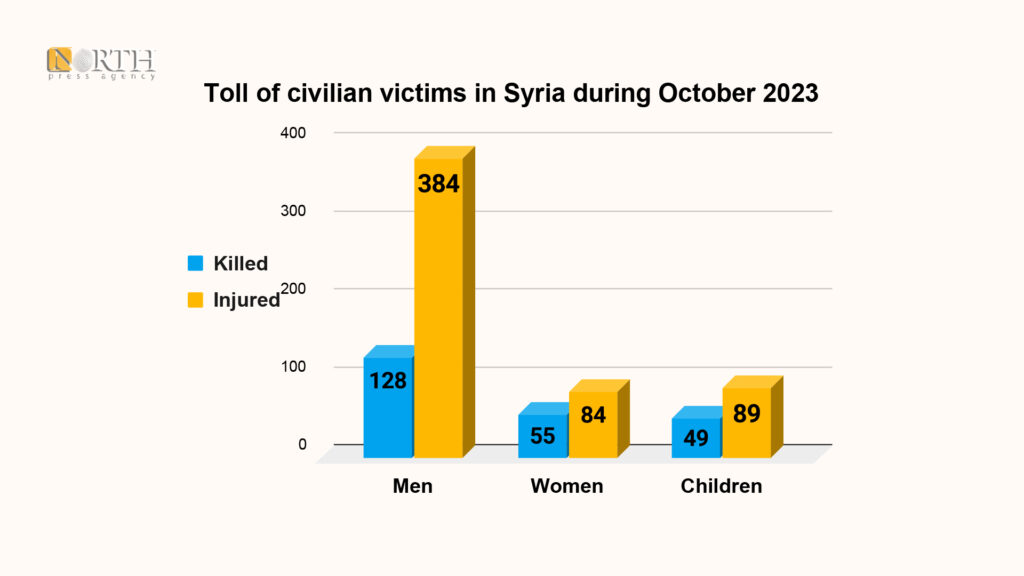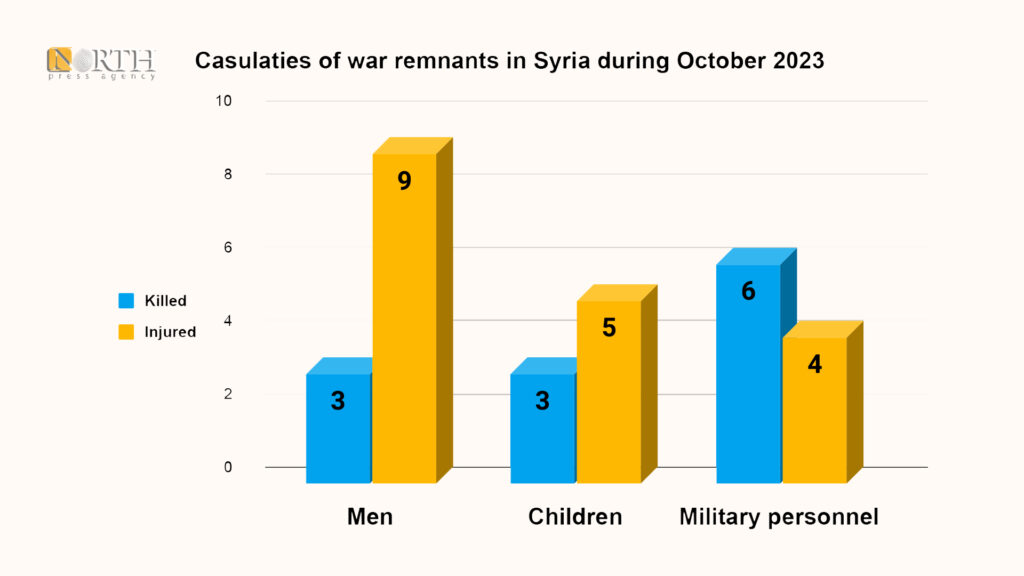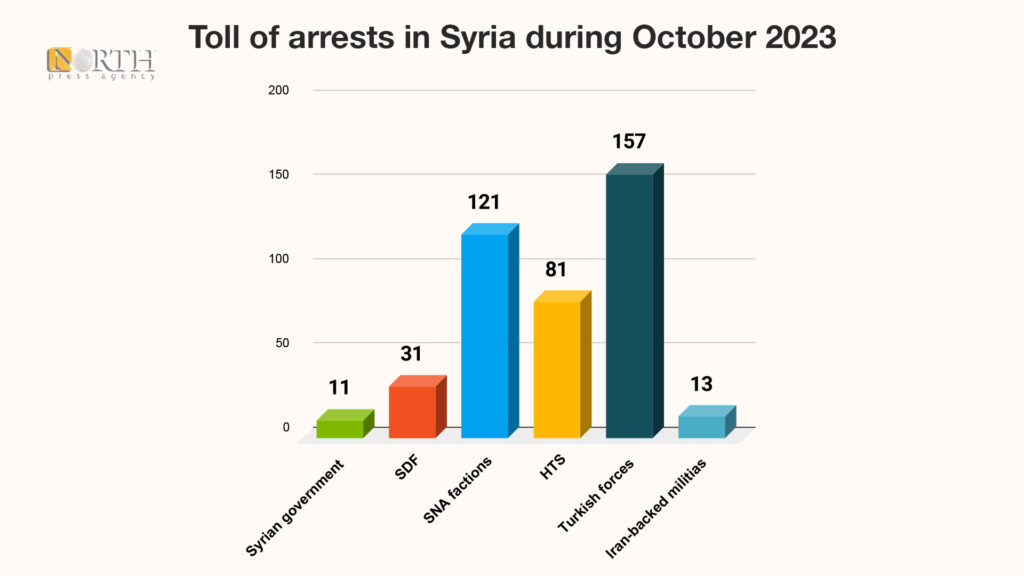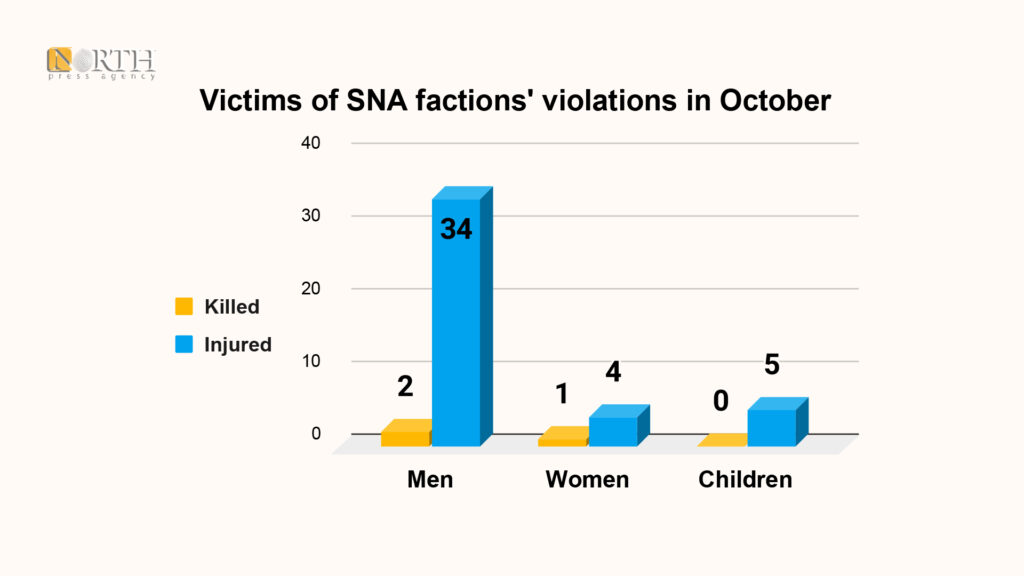Introduction
The rate of violations in Syria increased by about 26 percent during October compared to September with an increase in attacks against civilians by about 108 percent, marking the highest toll since the beginning of the year. Additionally, the military escalation among parties to the conflict rose by 37 percent, and the Islamic State (ISIS) activity increased by approximately 87 percent. Meanwhile, the arrest rate dropped by 20 percent, according to data analyzed by the Monitoring and Documentation Department of North Press.
The monthly report by the Monitoring and Documentation Department represents the most significant human rights violations documented during October based on information obtained by a network of field sources across Syria.
The report includes a toll of human rights violations, such as killings and arbitrary arrests by parties to the conflict, as well as, statistics on individuals who lost their lives due to war remnants deliberately planted by certain parties in areas under their control to protect themselves from hostile attacks, but subsequently cause monthly dozens civilian casualties.
It also shows the indiscriminate shelling carried out as an act of revenge by controlling forces according to their areas of control, its consequences on civilians and public properties, and there is also the ISIS activity, as well as, other issues that affect the rights of Syrian people, leading to their insecurity and instability.
Victims of Violations in Syria
During October, the department recorded the killing and injury of 1,464 individuals, both civilians and military personnel, of which 470 were killed, and 994 were injured either by direct attacks and indiscriminate shelling, or by torture, abuse, or other forms of inhumane treatment. All civilians were extrajudicially killed either by parties to the conflict or by unidentified gunmen amidst security chaos and the presence of multiple controlling powers, making it easy for criminals to escape punishment due to the absence of accountability.

Toll of victims
The civilian casualties numbered 789, where 232 were killed (including 49 children, 55 women, and 128 men), and 557 civilians were injured (including 89 children and 84 women). The civilian casualties across Syria were as follows: Idlib and its countryside recorded the highest number at 388, followed by Homs with 84, Aleppo with 80, Aleppo northern countryside with 66, Hasakah with 50, Deir ez-Zor with 46, 19 each in Hama and Daraa, 13 each in Qamishli and Raqqa, five each in Damascus and its countryside, and three each in Latakia and Suwayda.
As for the military casualties, the number reached 675 (238 killed and 437 injured). The count is distributed among the four conflicting parties in Syria. 109 soldiers of the Syrian government forces were killed and 316 others were wounded.
11 militants of the Turkish-backed armed opposition factions, aka the Syrian National Army (SNA), were killed, and 10 others were injured. 17 militants from Hayat Tahrir al-Sham (HTS, formerly al-Nusra Front) were killed and 18 others were wounded. Sixty-two fighters from the Syrian Democratic Forces (SDF) were killed, and 42 others were wounded. Fifteen Iranian-backed militants were killed, and 20 others were injured, as for the casualties rate of the non-Syrian nationals was 24 killed and 31 wounded.
The toll of the war remnant’s victims decreased by 25 percent compared to the previous month, recording the killing and wounding of 30 individuals. The toll was as follows: three children were killed and five others were injured, three men were killed and nine others were injured, and six military personnel were killed, and four others were injured.

Concerning the rate of shelling by parties to the conflict, Syria witnessed a surge by about 37 percent compared to September due to military escalation, unlawful shelling, and continuous clashes. 80 sites in the government-held areas were targeted with 141 strikes.
The HTS targeted 38 locations of the government forces with 38 strikes, Israel targeted 16 locations with 23 strikes, it also targeted one location for Hezbollah with three strikes, along with two others for the Iranian-backed militias with two strikes. The Turkish-backed SNA factions targeted two sites of the government forces with two strikes, while unknown parties targeted six sites with nine strikes, four sites of the Iranian-backed militias with seven strikes, and one civilian site with one strike. Turkey targeted five sites of the government with 44 strikes. Meanwhile, the US-led Global Coalition targeted three sites of the Iranian-backed militias with three strikes. The US forces targeted two sites of the Iranian-backed militias with nine strikes.
The shelling witnessed in these areas resulted in 469 casualties, 129 killed and 340 injured.
In the HTS-held areas, 321 sites were subjected to 429 strikes. The government forces targeted 262 sites with 327 strikes, and Russia hit 59 sites with 102 strikes. These strikes resulted in the killing of 111 individuals and injury of 265 others.
As for areas under the control of the SNA, 38 sites were shelled with 57 strikes. The government forces targeted two sites with two strikes, and four Turkish bases with four strikes. The SDF targeted five sites with five strikes, and 27 Turkish bases with 46 strikes. These strikes led to the killing of 31 individuals and the injury of 41 others.
In areas controlled by the SDF, 22 sites were attacked with 46 strikes. The government forces and their affiliated groups targeted four sites with seven strikes, the SNA targeted seven sites with seven strikes, as well as, the Islamic Resistance in Iraq targeted US bases at eight sites with 12 strikes, and Iranian-backed militias targeted three US bases with 20 strikes.
These attacks caused the killing of four individuals and the injury of 30 others.
Turkish forces targeted 335 sites in areas under the control of the government forces and the Autonomous Administration of North and East Syria (AANES) with 539 strikes, including 71 drone attacks, killing and injuring 118 individuals.
A decrease was recorded in the rate of arrests and forced disappearances by 20 percent compared to last September. The Department documented the arrest of 414 individuals in Syria by the conflicting parties. The highest percentage of arbitrary detentions was carried out by Turkish forces, with 37 percent. The second-highest percentage was recorded in areas under the control of the SNA, where 121 individuals were arrested, including 10 women and one child. Some were arrested on charges of dealing with the AANES and the SDF, while others were detained on the Syrian-Turkish border after being deported from Turkey.
Additionally, some other individuals were arrested on baseless charges. Among the arrestees, seven were involved in carrying out attacks against militants affiliated with the SNA and others during settling a dispute among leaderships of the Ninth Brigade over sharing robberies from olive fields of Kurdish people, who were displaced, and smuggling of drugs and antiquities. Furthermore, five individuals from the government forces were arrested, one was during an attempt to enter Turkish territory, and the others on unknown charges.
In the areas of the AANES, 31 individuals were arrested, 27 of them accused of belonging to ISIS.
In the HTS-held areas, 81 individuals were arrested, including three women. Among the charges brought against them was working for external entities. Some detainees were received from Turkish border guards, which had previously arrested them while attempting to cross into Turkey, while others were received from Turkish authorities on charges of working for external entities. Three militants of the SNA were also among those detained.
In the Syrian government-held areas, 24 individuals were arrested, 13 of them were detained by Iranian-backed militias among them were five shepherds who were arrested following an attack on an Iranian-backed militias’ patrol by unidentified individuals near the Syrian-Iraqi border. The other arrests were carried out on suspicion of involvement in detonating an improvised explosive device (IED) in a car of an Iranian-backed leader. 11 individuals who were arrested by government forces, and most of them were held arbitrarily without arrest warrants.
Turkish forces, represented by intelligence personnel and Turkish border guards, arrested 157 individuals, 109 of them were arrested by the Turkish border guards while attempting to cross into Turkish territory, including 14 women and five children. Turkish intelligence arrested the remaining 48 individuals, including seven women, most of whom were charged with dealing with the SDF. Out of this total, 32 individuals, including seven women and three individuals of non-Syrian nationalities (Iranian, French, and Qatari), were transferred to Turkish prisons on charges of working for and belonging to the SDF.

ISIS activity
In comparison to September, ISIS activity in Syria in October recorded an increase by about 87 percent, with a total of 15 attacks, 11 of which were claimed by the group. ISIS targeted the SDF 12 times, the Syrian government two times, and one attack was against civilians. The attacks were distributed as follows: ten in Deir ez-Zor, two in Homs, and one each in Raqqa, Hasakah, and Manbij.
The ISIS attacks resulted in 23 casualties either by direct attacks or through IEDs and mines. The attacks claimed the lives of 13 military personnel and wounded eight individuals, including 8 military personnel.
The toll of the anti-ISIS security operations in October was 9, during which 27 ISIS suspects were arrested. The SDF conducted 8 operations, 6 of which were in collaboration with the US-led Global Coalition, and one airdrop operation. The operations resulted in the arrest of 27 ISIS suspects.
Meanwhile, the Syrian government carried out one security operation against the group that resulted in the killing of two individuals and the wounding of two others.
Violations of SNA and Turkish forces in Syria
The SNA, during October, killed three individuals, including a woman. The Third Legion security forces, affiliated with the Turkish-backed SNA, tortured a civilian to death in the Kafr Janneh prison in the countryside of Afrin, northwest Syria. The SNA factions also caused the wounding of 43 individuals, including four women and five children.
The SNA factions also carried out 19 cases of appropriation of civilian properties in Afrin. The Department documented one appropriation case against three aid trucks loaded with materials for “Winter Heating” project in the city and countryside of Sere Kaniye (Ras al-Ain)in northern Hasakah, northeast Syria.
Five cases of imposing royalties of various amounts by the SNA factions on owners of olive lands and olive mills, and on vehicles loaded with olive were recorded. Additionally, cases of imposing royalties on individuals in turn for setting them free or on those deported from Turkey were also recorded, five by the Turkish-backed Sultan Suleiman Shah faction (al-Amshat) and one by each of the Civil Police, the Sultan Murad faction, Jaysh al-Sharqiyah, The Third Legion, Sham Legion, and Glory Corps. The remaining imposed royalties were committed by other factions jointly.
The North Press Monitoring and Documentation Department recorded 24 cases of robbery, along with the cutting of 480 fruitful and forest trees in Afrin by the SNA factions. In Sere Kaniye (Ras al-Ain), two cases of excavation were recorded.

Turkish forces continue to commit violations of human rights and international humanitarian law in Syria by indiscriminately shelling areas in northeast Syria and directly targeting asylum seekers. These violations resulted in 252 casualties, where 51 were killed, including two women and two children, and 201 were injured, including 30 women and 15 children.
According to the department’s toll, Turkish border guards killed two asylum seekers, including a woman, and wounded 25 others, including three women and four children, by directly shooting them with live bullets while they tried to cross the Syrian-Turkish border. They also wounded 107 individuals, including 20 women and five children, by assaulting and beating them.
Turkish forces’ shelling on areas in northern Syria caused 118 casualties, killing 49 individuals, including a woman and two children, and injuring 69 others, among them were seven women and six children.
International and regional actions on Syria
In October, several human rights reports, statements, political and humanitarian resolutions related to Syria were issued. Various UN and international meetings were held, in addition to the occurrence of changes in stances and decisions concerning the country.
On October 24, Paulo Pinheiro, Head of the UN Commission of Inquiry, said in a statement that the fighting in Syria has reached its worst in years with no regard for civilian lives. He stressed in the statement that “there appears to be total disregard for civilians lives in what are often tit for tat reprisals.”
He also mentioned a number of hostilities the country underwent during the month, including the drones attack on Homs Military Academy, shelling of Idlib and west of Aleppo by the Syrian government and Russia, and the Turkish shelling of areas in northeastern Syria.
On the back of the Turkish shelling of northeast Syria, Human Rights Watch reported on October 26 that the recent Turkish drone strikes on “Kurdish-held areas of northeast Syria” damaged critical infrastructure and resulted in water and electricity outages for millions of people.
In a briefing to the Security Council on October 30, Edem Wosornu, OCHA Director of Operations and Advocacy, highlighted the deteriorating humanitarian situation and the major increase in hostilities in October in several areas across northern Syria, representing the most significant escalation in violence since 2019 in northwest Syria.
She added that over two weeks from 5 to 18 October, more than 120,000 people were displaced in Idlib and western Aleppo.
With regard to areas in northeastern Syria, she said the recent spike in hostilities damaged critical civilian infrastructure, including power stations and water facilities.
The United Nations Special Envoy for Syria, Geir Pedersen, warned during the same session of the regional developments occurring and their risk on Syria, saying, “Spillover into Syria is not just a risk; it has already begun.”
He stressed, “The situation is now at its most dangerous for a long time,” Pointing to the alarming developments between Israel and Hamas and the region.

